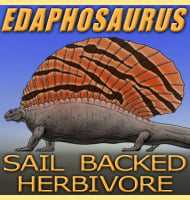
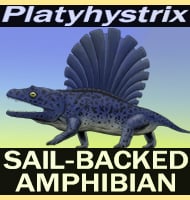
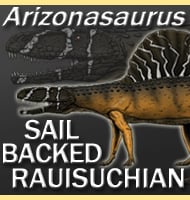
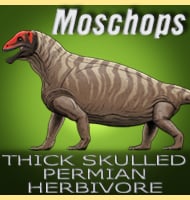
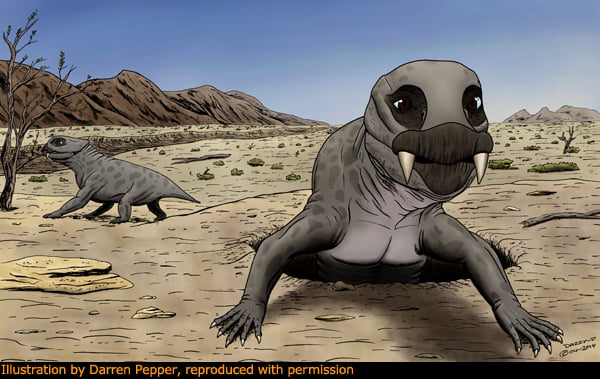
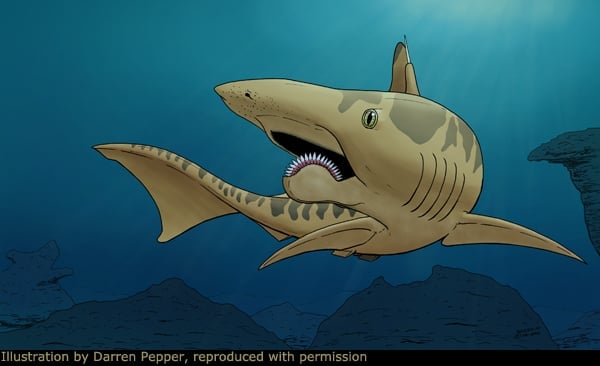
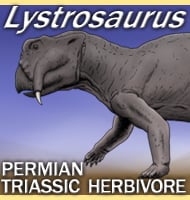
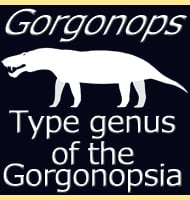

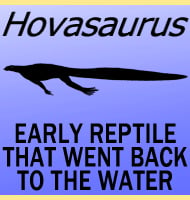
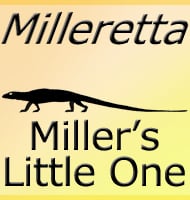
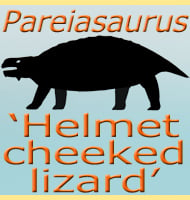
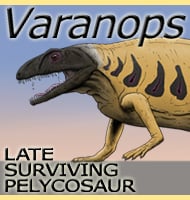
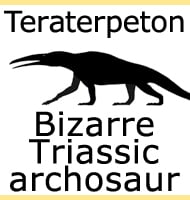
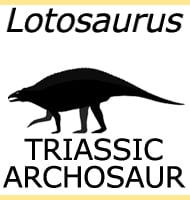
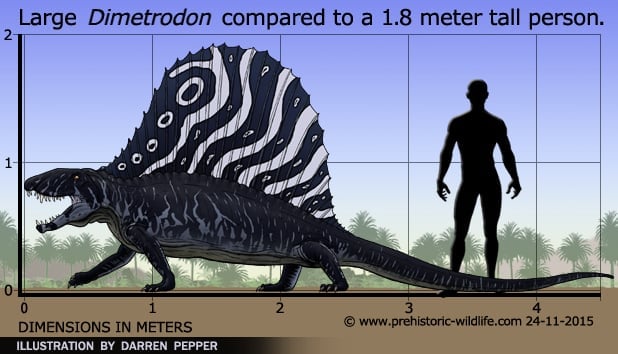
Nazwa: Dimetrodon(Twomeasures of teeth).
Phonetic: Di-met-ro-don.
Nazwa nadana przez: Edward Drinker Cope – 1878.
Synonimy: Bathyglyptus, Bathygnathus?,Embolophorus, Eosyodon,Theropleura.
Klasyfikacja: Chordata, Tetrapoda, Amniota,Synapsida, Pelycosauria, Sphenacodontidae.
Gatunki: D. angelensis, D. booneorum, D.borealis, D.dollovianus, D. fritillus, D. giganhomogenes, D. gigas, D. grandis, D.limbatus, D. loomisi, D. macrospondylus, D. milleri, D. natalis, D.occidentalis, D. platycentrus, D. teutonis.
Dieta: Mięsożerna.
Wielkość: W zależności od gatunku, od 1,7 do 4,6 metra długości.
Znane miejsca występowania: Niemcy – Formacja Tambach. USA,Nowy Meksyk – Formacja Cutler; Oklahoma – Formacja Garber, Formacja Hennessey, Formacja Wellington; Teksas – Formacja Arroyo, Formacja Admiral, Formacja Bead Mountain, Formacja Belle Plains, Formacja Nocona, Formacja Petrolia, Formacja Putnam, Formacja Vale, Formacja Waggoner Ranch.
Czas trwania: Artinskian do Roadian permu.
Reprezentacja skamieniałości: Wiele okazów zostało odkrytych, dzięki czemu morfologia Dimetrodona jest łatwa do ustalenia.
Często uważany za dinozaura, Dimetrodon był w rzeczywistości jednym z pelykozaurów i poprzedzał najwcześniejsze dinozaury o dziesiątki milionów lat. Jego popularność pochodzi od masywnego żagla, który jest niesionyerect na plecach, dokładny cel, który jest nadal nieznany, ale spekulowano, że jest do celów wystawowych albo przyciągnąć kolegów lub zastraszyć rywali. Inną teorią jest to, że był używany fortemperature regulacji. zimna krew zwierząt są zawsze ospały untilthey może podnieść ich temperatury ciała. Jeśli Dimetrodonflushed bloodinto its sail to raise its temperature, it would have a significantadvantage over its prey items that would have still been too slow andsluggish toescape. To jest oczywiście całkowicie prawdopodobne, że obie teorie sącorrect.
Dimetrodonhad bardzo udany drapieżnik projekt i jego szeroki expansein linii czasu zapisu kopalnego i dystrybucji geograficznejremains są dowodem na to. Oprócz potencjalnej korzyści zcontrolowane termoregulacji, Dimetrodon miał dwa różne rodzaje zębów, stąd powód jego nazwy. Zęby te składały się z zębów zaprojektowanych do chwytania zdobyczy, oraz zębów zaprojektowanych do cięcia mięsa. Oprócz bardziej efektywnych zabójstw, zęby te umożliwiłyby Dimetrodonowi wykonanie krótkiej pracy przy jedzeniu przedmiotów należących do itsprey. Wcześniejsze przykłady Dimetrodona wydają się mniejsze niż późniejsze skamieniałości.
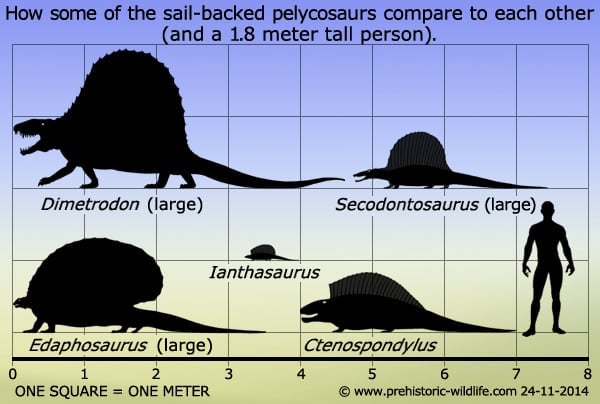
Ctenospondylus,Dimetrodon,Edaphosaurus,Ianthasaurus,Secodontosaurus.
Dalsza lektura
– Descriptions of extinct Batrachia and Reptilia from the Permianformations of Texas. – Proceedings of the American PhilosophicalSociety 17:505-530. – Edward Drinker Cope – 1878.
– The history of the Pelycosauria, with a description of the genusDimetrodon, Cope. – Transactions of the AmericanPhilosophical Society20 (1): 5-62. – G. Baur & E. C. Case – 1899.
– Notes on the Permo-Carboniferous reptile Dimetrodon.- The Journal ofGeology 35 (8): 673-689. – A. S. Romer – 1927.
– The skeleton of an immature pelycosaur, Dimetrodoncf. grandis, fromthe Permian of Texas. – Journal of Paleontology 16 (4): 485-486. – C.W. Sternberg – 1942.
– The San Angelo Formation, Permian of Texas, and its vertebrates. -The Journal of Geology 61 (5): 389-423. – E. C. Olsen & J. R. Beerbower – 1953.
– Parallelism in the evolution of the Permian reptilian faunas of theOld and New Worlds. – Fieldiana 37 (13): 385-401. – Everett C. Olson -1955.
– Comparison of the Early Permian vertebrate faunas of the Four Cornersregion and north-central Texas. – Los Angeles County Museum of NaturalHistory Contributions in Science 105: 1-13. – P. P. Vaughn – 1966.
– Wczesnopermskie kręgowce z południowego Nowego Meksyku i ich znaczenie paleozoogeograficzne. – Los Angeles County Museum of NaturalHistory Contributions in Science 166: 1-22.. – P. P. Vaughn – 1969.
– A new species of Dimetrodon (Reptilia,Pelycosauria) from anon-deltaic facies in the Lower Permian of north-central New Mexico. -Journal of Paleontology 51 (1): 108-115. – D. S. Berman – 1977.
– A thermal model of the sailback pelycosaur. – Paleobiology 12 (4):450-458. – S. C. Haack – 1986.
– A new species of Dimetrodon (Synapsida:Sphenacodontidae) from theLower Permian of Germany records first occurrence of genus outsideNorth America. – Canadian Journal of Earth Sciences 38: 803-812. – D.S. Berman, R.R. Reisz, T. Martens & A. C. Henrici – 2001.
– Naturalne środowisko i zachowanie termiczne Dimetrodonlimbatus. -Journal of Thermal Biology 26 (1): 15-20. – G. A. Florides, S. A. Kalogirou, S. A. Tassou & L. Wróbel – 2001.
– Histologiczna analiza traumatycznego uszkodzenia wielu neuronalnych kolców szkieletu Dimetrodon: Implications for healingresponse, dorsal sail morphology and age-at-death in a Lower Permiansynapsid. – Integrated Comparative Biology 44: 628. – E. A. Rega, K.Noriega, S. Sumida & A. Lee – 2004.
– Evidence-based paleopathology I: Ontogenetic and functionalimplications of dorsal sails in Dimetrodon. – Journal of VertebratePaleontology 25 (S3): 103A. – E. Rega, S. Sumida, K. Noriega, C. Pell& A. Lee – 2005.
– Evidence-based paleopathology II: Impact on phylogenetic analysis ofthe genus Dimetrodon. – Journal of VertebratePaleontology 25 (S3):120A. – S. Sumida, E. Rega & K. Noriega – 2005.
– A new record of the Early Permian pelycosaurian-grade synapsidDimetrodon (Eupelycosauria: Sphenacodontidae) fromthe Lower CutlerGroup (Early Permian) of Jemez Pueblo, north-central New Mexico. -Journal of Vertebrate Paleontology 27 (3, Suppl.): 110A. – K. Madalena,S. Sumida, K. Zeigler & E. Rega – 2007.
– Evolution of bone microanatomy of the tetrapod tibia and its use inpalaeobiological inference. – Journal of Evolutionary Biology 21 (3):807-826. – A. Kriloff, D. Germain, A. Cranoville, P. Vincent, M. Sache& M. Laurin – 2008.
– Dimetrodon (Amniota: Synapsida: Sphenacodontidae)from the LowerPermian Abo Formation, Socorro County, New Mexico. – New MexicoGeological Society Guidebook 60. New Mexico Geological Society. pp.281-284. – S. G. Lucas, J. A. Spielmann, L. F. Rinehart & T. Martens – 2009.
– Comparative anatomy and osteohistology of hyperelongate neural spinesin the sphenacodontids Sphenacodon and Dimetrodon(Amniota: Synapsida).- Journal of Morphology 271 (12): 1407-1421. – A. K. Huttenlocker, E. Rega & S. S. Sumida – 2010.
– Healed Fractures in the Neural Spines of an Associated Skeleton ofDimetrodon: Implications for Dorsal Sail Morphologyand Function. -Fieldiana Life and Earth Sciences 5: 104. – E. A. Rega, K. Noriega, S.S. Sumida, A. Huttenlocker, A. Lee & B. Kennedy – 2012.
—————————————————————————-
Losowe ulubione
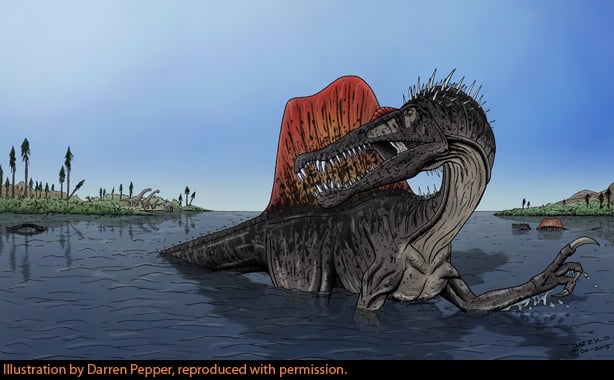 |
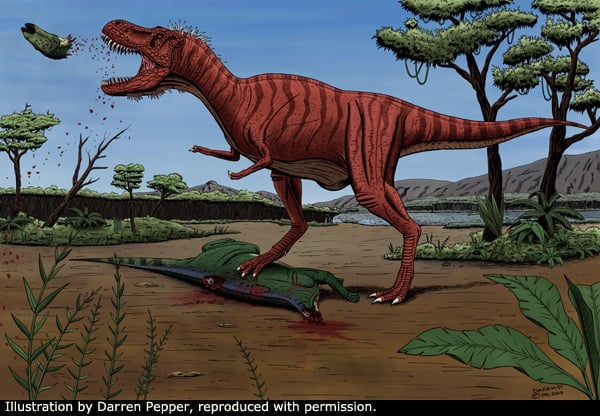 |
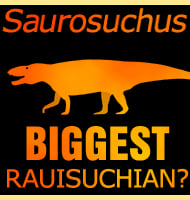 |
Privacy& Cookies Policy